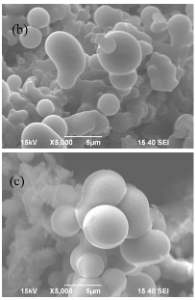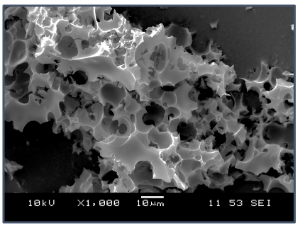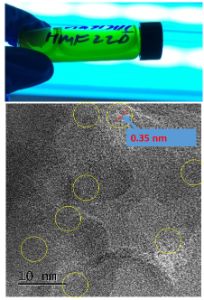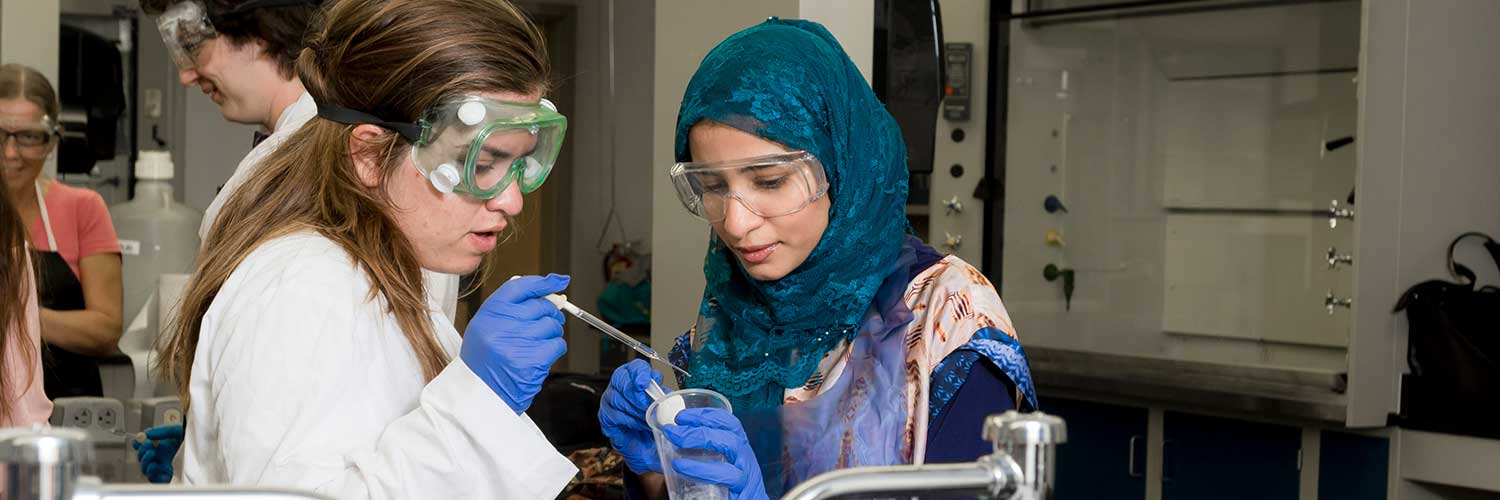 Materials synthesis, characterization, and application are a large sector of chemical engineering. Projects in this area involve synthesis and characterization of novel materials including but not limited to nanomaterials, carbon dots, activated carbons. Both bottom up and top down approaches are employed to synthesize materials.
Materials synthesis, characterization, and application are a large sector of chemical engineering. Projects in this area involve synthesis and characterization of novel materials including but not limited to nanomaterials, carbon dots, activated carbons. Both bottom up and top down approaches are employed to synthesize materials.
Florida Tech has dedicated material characterization equipment (e.g., scanning electron microscope, transmission electron microscope, Atomic Force Microscope, Fourier Transform Infrared Spectroscopy, Thermogravimetric Analyzer, X-ray Diffraction) to characterize materials.

Reza Research Group | Dr. Toufiq Reza
Dr. Reza's research group is synthesizing microporous activated carbon like materials from waste biomass, called superactivated hydrochar, for hydrogen storage.
We are moving into hydrogen economy and hydrogen is rapidly becoming the clean source of energy for everyday use. One of the major challenges of hydrogen energy is the storage of hydrogen gas. Hydrogen storage materials require extremely high surface area, large pore volume, low pore size, functionality. Projects in this area focus on thermochemical conversion of waste biomass into carbon materials with desired characteristics for hydrogen storage.

Carbon quantum dots (CQD) are discrete and quasi-spherical nanoparticles (size <10 nm) with amorphous to a nanocrystalline core with predominantly sp2 carbon. They show prominent fluorescence properties. Current applications include but are not limited to biosensing, bioimaging, medical diagnosis, drug delivery, multicolor patterning, ion detection, photocatalysis, coating, and solar cells. Ongoing projects in this area focus on synthesizing CQDs from waste biomass by using hydrothermal conversion techniques.
The study of molecular transport and heterogeneous reaction kinetics in fibrous porous media is a key field of research, applicable to many areas of science, industry and technology. The ability to understand and predict the molecular transport and surface interactions in fibrous porous materials is extremely valuable to the broader fields of textiles, filtration, paper, fuel cells, composites, tissue engineering, and catalysis.
The science of porous materials continues to progress due in part to their prevalence in the natural world as well as their capability to provide high surface areas for hosting and promoting reactions of interest. Many modern applications seek to leverage advances in tuning pore size and shape, as well as controlling the surface interactions occurring at the pore interface. The evolution of theoretical and computational models that describe molecular flow and surface interactions in fibrous porous systems is key to providing insight into experimental results and predictive capabilities for advanced design efforts.
This research effort uses a numerical modeling technique to explore the transport, survival, and overall effective reaction rates of molecules diffusing in the pore space formed by three-dimensionally random groupings of fibers with finite surface reaction rates. The developed algorithm enables the exploration of systems with surface incorporation rates and diffusion rates in the full spectrum between the extremes of diffusion-controlled and reaction rate-controlled processes. The effects of porosity and surface reaction rate on the dimensionless principal relaxation time are also analyzed for applications in nuclear magnetic resonance (NMR).
One of the key outcomes of this study is the first ever theoretical prediction for the transition regime pseudo-homogenous reaction rate constant in any type of porous media, throughout the spectrum from diffusion-controlled to reaction-controlled process conditions.
Tomadakis Group | Dr. Manolis Tomadakis
The fibrous media industry has a remarkable impact on the world economy. Such media are used in our daily life in many forms, including thermal insulation, clothing, paper products, sporting goods, materials used in civil construction, the aerospace and automobile industry, and defense applications. Prediction of the viscous permeability of fibrous materials is essential in those and other applications of such media, including composite fabrication techniques, fuel cell gas diffusion layers, fibrous filters and membranes, and physiological systems and processes.
A method derived from electrical conduction principles was combined in the Tomadakis group with Brownian diffusion random-walk simulation results to model the viscous permeability of such structures. The results were compared to experimental data of the literature, resulting in an overall ratio of theoretical prediction to experimental measurement in the proximity of 1 for the over 500 experimental points utilized. This study has since been the most broadly cited numerical investigation of the literature on the viscous permeability of fibrous media.
Tomadakis Group | Dr. Manolis Tomadakis
Bimodal fibrous media have recently attracted increased attention due to the distinctive properties and enhanced performance resulting from the combination of fibers of two different diameters.
For instance, fibrous media used as air filtration devices in the health, agriculture, automotive, and civil industries, are typically made up of mixtures of bimodal fibers, with a fiber diameter ratio between 2 and 5; the thinner fibers provide for a higher filtration efficiency and the thicker ones for enhanced mechanical strength.
Other applications of bimodal fibrous media have been reported in areas as diverse as fiber-reinforced composite materials, fibrous insulations, diapers and other hygiene products, as well as in the medical and biomedical fields; the latter include tissue engineering scaffolds, diagnosis of neuromuscular disorders through electromyography, fibrin fiber dispersity effects on thrombosis, and histological studies and spinal nerve regeneration procedures in animals.
A 2020 numerical and analytical study by Dr. Manolis Tomadakis and co-workers was the first to report on any of the following properties of such structures: Mean intercept length, effective Knudsen, transition, and bulk diffusivity and tortuosity, and formation factor, the latter accounting for the effective thermal and electrical conductivity and magnetic permeability, dielectric constant, and refractive index. Numerical results were also reported for the viscous permeability of the structures, and were found to be in excellent agreement with a multitude of experimental data of the literature.


 Give to Florida Tech
Give to Florida Tech 